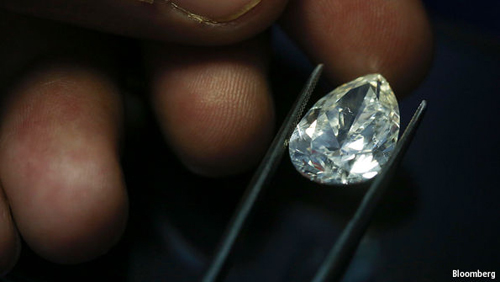
Brides who want a diamond now have alternatives in the form of synthetic diamonds, which have improved in quality and become less costly to produce. De Beers and other miners are working to boost demand, with new advertising campaigns and slogans.

Brides who want a diamond now have alternatives in the form of synthetic diamonds, which have improved in quality and become less costly to produce.
IN THE frozen tundra of northern Canada, miners are working day and night to ramp up production at Gahcho Kué. Owned by De Beers, it is the biggest new diamond mine to open in more than a decade. It may also be the company’s last—De Beers has no plans to open another. Other companies have a few mines planned, but Bain, a consultancy, expects diamond production to peak in 2019, then begin a slow decline. Why is the world about to reach peak diamond?
The modern diamond industry got going about 150 years ago, when a farmer’s son found a diamond near the Orange River in South Africa. A diamond rush followed, with a surge of production threatening to send prices plummeting. In 1888 Cecil Rhodes founded De Beers to consolidate the area’s mines. The company would retain a stranglehold on supply for more than a century. “Our only risk,” Rhodes later declared, “is the sudden discovery of new mines, which human nature will work recklessly to the detriment of us all.”
Much has changed since then. De Beers now controls only about one-third of the market. It regards any big discoveries, by itself or anyone else, to be unlikely. Explorers have sampled nearly 7,000 kimberlite pipes, the extinct volcanoes that brought most gem diamonds to the surface. Of these just 15% held diamonds and only 1% (about 60) contained enough to justify the cost of building a mine. Though exploration continues, most analysts reckon the best deposits have already been found.
For those who dig up diamonds, waning supply is a relief; it will help prop up prices. Brides continue to want diamond engagement rings—in America, De Beers reports, a quarter of young brides dreamed of their rings years before beginning a relationship. But there are signs that demand might falter. Those in the millennial generation earn less than their parents did at their age and are less interested in material luxury. They grew up as awareness of “blood diamonds”, which are mined to fund conflict and are illegal, entered popular culture. Brides who want a diamond now have alternatives in the form of synthetic diamonds, which have improved in quality and become less costly to produce. De Beers and other miners are working to boost demand, with new advertising campaigns and slogans. But it helps that supply is not forever.